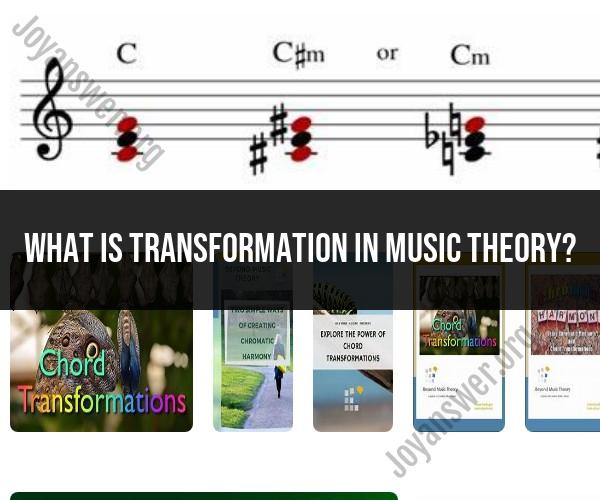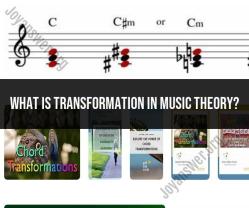What is transformation in music theory?
Transformation in music theory refers to the process of altering a musical composition through various operations or techniques while preserving some essential elements of the original material. These transformations can involve changes in pitch, rhythm, or other musical characteristics. Transformations are commonly used in the field of music composition and analysis to explore and develop musical ideas. Here are some key concepts and applications of transformation in music theory:
1. Inversion: Inversion is a common transformation that involves reversing the direction of intervals within a musical passage. For example, if you invert a melody, ascending intervals become descending, and vice versa. Inversion is often used to create variations in themes or motifs.
2. Retrograde: Retrograde transformation entails playing a musical passage backward. This technique can provide a new perspective on a composition and is often used for compositional experimentation.
3. Transposition: Transposition involves moving a musical passage up or down in pitch while maintaining the same intervals and relationships between notes. Transposition is a fundamental concept in music and is used to modulate between keys, create variations, or adapt music for different instruments.
4. Rhythmic Transformations: Transformations in rhythm can include changing the tempo, time signature, or rhythmic patterns within a piece of music. These transformations can add interest and complexity to a composition.
5. Tonal Transformations: In tonal music, transformations may involve altering the harmony, chords, or key of a composition. These changes can create different emotional or expressive qualities within the music.
6. Serialism: In the context of serialism (a compositional technique associated with 20th-century music), transformations involve manipulating a predetermined series of pitch classes and using operations like inversion, retrograde, and transposition to generate musical material.
7. Algorithmic Composition: Advances in computer technology have enabled composers to use algorithms and software to create complex transformations in their compositions. These algorithms can generate intricate and evolving musical structures.
The use of transformations in music theory allows composers to explore new possibilities and create variations within their compositions. It also provides tools for music analysts to study the structure and relationships within a piece of music. Transformations are a fundamental aspect of music theory, contributing to the richness and diversity of musical expression.
Music Theory and the Concept of Transformation
Transformation is a fundamental concept in music theory. It refers to any operation that can be applied to a musical object, such as a melody, chord, or rhythm, to produce a new musical object. Transformations can be used to create variation, development, and contrast in music.
Transformative Processes in Music Composition
There are many different transformative processes that composers can use in their music. Some common transformative processes include:
- Transposition: Transposition is the movement of a musical object up or down in pitch.
- Inversion: Inversion is the reversal of the direction of the intervals in a musical object.
- Retrograde: Retrograde is the playing of a musical object backwards.
- Augmentation: Augmentation is the lengthening of the duration of a musical object.
- Diminution: Diminution is the shortening of the duration of a musical object.
Composers can also use combinations of these transformative processes to create more complex musical transformations.
Analyzing Musical Transformations in Compositions
To analyze musical transformations in compositions, it is helpful to identify the following:
- The original musical object
- The transformative process that was applied
- The new musical object that was created
Once you have identified these elements, you can begin to understand how the composer used transformation to create variation, development, and contrast in their music.
Notable Examples of Transformation in Music
Here are some notable examples of transformation in music:
- In Beethoven's Fifth Symphony, the composer uses the motive "short-short-short-long" throughout the symphony, transforming it in various ways to create new melodies and rhythms.
- In Bach's Goldberg Variations, the composer transforms a simple aria into 30 different variations, using a variety of transformative processes, such as transposition, inversion, retrograde, and augmentation.
- In Stravinsky's ballet The Rite of Spring, the composer uses complex rhythmic transformations to create a sense of energy and excitement.
Theoretical Frameworks for Understanding Musical Transformation
There are a number of theoretical frameworks that can be used to understand musical transformation. One common framework is the Transformational Theory developed by David Lewin in the 1980s. Lewin's theory models musical transformations as functions that act on musical objects.
Another theoretical framework for understanding musical transformation is the Neo-Riemannian Theory. This theory is based on the idea that all triads are related to each other by a small number of basic transformations.
Both of these theoretical frameworks can be used to analyze musical transformations in a wide variety of musical styles.
Conclusion
Transformation is a powerful tool that composers can use to create variation, development, and contrast in their music. By understanding the concept of transformation and the different transformative processes that can be used, we can gain a deeper appreciation for the music that we listen to and play.


